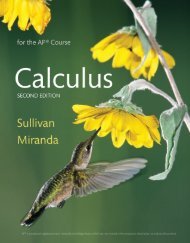SPA 3e_ Teachers Edition _ Ch 6
You also want an ePaper? Increase the reach of your titles
YUMPU automatically turns print PDFs into web optimized ePapers that Google loves.
Promoting Good Habits and Skills<br />
<strong>Ch</strong>apter 6 is about the characteristics of sampling distributions.<br />
The sampling distribution of the sample proportion<br />
and sample mean will play a key role in <strong>Ch</strong>apters 7–9, so<br />
understanding them is very important for future success.<br />
Here are some important habits to develop in your students<br />
as you teach <strong>Ch</strong>apter 6:<br />
1. Pay attention to the vocabulary: Understanding the differences<br />
among population, parameter, sample, and statistic is<br />
absolutely vital to understanding this and future chapters.<br />
Also, make sure your students understand the difference<br />
between the distribution of the population, the distribution<br />
of a single sample, and the sampling distribution. They are<br />
not the same!<br />
2. Emphasize symbols, not formulas: The symbols used in<br />
this chapter are quite standard in all of statistics. While we<br />
don’t want the symbols to overwhelm students, they are<br />
an integral part of basic statistical practice. The symbols<br />
n, p, p^ , m, s, and x will be used extensively in <strong>Ch</strong>apters<br />
7–9. Being comfortable with them now will be of great<br />
help later. On the other hand, don’t have students memorize<br />
the formulas for the mean and standard deviations of<br />
the sampling distributions in this chapter. Having students<br />
understand the symbols is far more important than having<br />
them memorize the formulas.<br />
3. Look for the underlying variable: If your students can<br />
recognize the underlying variable and classify it as categorical<br />
or quantitative, they can tell which sampling distribution<br />
is appropriate. Categorical variables (like color of<br />
a Reese’s Pieces ® candy) lead to sample counts and sample<br />
proportions. Quantitative variables (like the year a penny<br />
was manufactured) lead to sample means. Developing this<br />
skill now will pay dividends in future chapters as well!<br />
4. Think back to the simulations: Because sampling distributions<br />
are very abstract, simulating the sampling process can<br />
provide insight for students. If students have trouble understanding<br />
the different distributions in sampling situations,<br />
have them think back to concrete simulations like the<br />
“A penny for your thoughts?” activity in Lesson 6.1 and<br />
computer simulations with software like the <strong>SPA</strong> applets.<br />
Physical simulations are so important for student understanding<br />
that if you were to do only one activity in the entire<br />
chapter, it should be the penny activity.<br />
5. Watch the conditions: Students will often pay little attention<br />
to the conditions about sampling distributions. Have<br />
them focus on the Large Counts condition and the Normal/<br />
Large Sample condition because these concepts will be used<br />
repeatedly in future chapters. If students don’t pay attention<br />
to them now, they will have a more difficult time in the<br />
future.<br />
Lesson-by-Lesson Content<br />
Overview<br />
Lesson 6.1 What Is a Sampling Distribution?<br />
A large collection of individuals is called a population.<br />
A subset of that population is called a sample. A number<br />
that measures some characteristic of a population is<br />
called a parameter, while a numerical measure of some<br />
characteristic of a sample is called a statistic. Statistics<br />
vary from sample to sample. The distribution of values<br />
taken on by a statistic from every possible sample of a<br />
given size is called the sampling distribution of that statistic.<br />
We can evaluate claims about a parameter by calculating<br />
probabilities from the sampling distribution of<br />
the corresponding statistic.<br />
6-4<br />
C H A P T E R 6 • Sampling Distributions<br />
Starnes_<strong>3e</strong>_ATE_CH06_398-449_v3.indd 4<br />
11/01/17 3:51 PM




